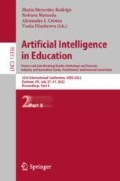Abstract
Spoken language variation analysis is increasingly considered in multimodal settings combining knowledge from computer, human and social sciences. This work focuses on second language (L2) acquisition via the study of linguistic variation combined with eye-tracking measures. Its goal is to model L2 pronunciation, to understand and to predict through AI techniques the related metacognitive information concerning reading strategies, text comprehension and L2 level. We present an experimental protocol involving a reading aloud setup, as well as first data collection to gather L2 speech with associated eye-tracking measures.
Access this chapter
Tax calculation will be finalised at checkout
Purchases are for personal use only
References
Ai, H., Lu, X.: A web-based system for automatic measurement of lexical complexity. In: ALICO-2010, pp. 8–12, June 2010
Augereau, O., Fujiyoshi, H., Kise, K.: Towards an automated estimation of English skill via TOEIC score based on reading analysis. In: ICPR 2016, pp. 1285–1290 (2016)
Azmat, G., Iriberri, N.: The importance of relative performance feedback information: evidence from a natural experiment using high school students. J. Publ. Econ. 94(7–8), 435–452 (2010)
Berzak, Y., Katz, B., Levy, R.: Assessing language proficiency from eye movements in reading. In: NAACL 2018: HLT, vol. 1, pp. 1986–1996. ACL, New Orleans, June 2018
Billières, M.: Méthode verbo tonale : diagnostic des erreurs surlaxe clair/sombre.www.verbotonale-phonetique.com/methode-verbo-tonale-diagnostic-erreurs-axe-clair-sombre/
Derakhshan, A., Salehi, D., Rahimzadeh, M.: Computer-assisted language learning (call): pedagogical pros and cons. Int. J. Engl. Lang. Lit. Stud. 4, 111–120 (2015)
El Baha, M., Augereau, O., Kobylyanskaya, S., Vasilescu, I., Laurence, D.: Eye got it: a system for automatic calculation of the eye-voice span. In: 15th IAPR DAS (2022)
Flege, J.: Second language speech learning: theory, findings and problems, pp. 229–273 (1995)
Frenck-Mestre, C.: Eye-movement recording as a tool for studying syntactic processing in a second language: a review of methodologies and experimental findings. Second Lang. Res. 21 (2005)
Godfroid, A., Winke, P., Conklin, K.: Exploring the depths of second language processing with eye tracking: an introduction. Second Lang. Res. 36(3), 243–255 (2020)
Goulas, S., Megalokonomou, R.: Knowing who you are: the effect of feedback information on short and long term outcomes. Economic rese, Department of Economics, University of Warwick (2015)
Guryan, J., Kim, J.S., Park, K.H.: Motivation and incentives in education: evidence from a summer reading experiment. Econ. Educ. Rev. 55, 1–20 (2016)
Huettig, F., Rommers, J., Meyer, A.: Using the visual world paradigm to study language processing: a review and critical evaluation. Acta Psychologica 137, 151–71 (2011)
Kang, S.: Exploring L2 English learners articulatory problems using a read-aloud task (2020)
Kumar, M.: Advanced Educational Technology. Sankalp Publication, Bilaspur (2020)
Lallé, S., Conati, C., Azevedo, R.: Prediction of student achievement goals and emotion valence during interaction with pedagogical agents. In: AAMAS 2018, pp. 1222-1231 (2018)
Lallé, S., Murali, R., Conati, C., Azevedo, R.: Predicting co-occurring emotions from eye-tracking and interaction data in MetaTutor. In: Roll, I., McNamara, D., Sosnovsky, S., Luckin, R., Dimitrova, V. (eds.) AIED 2021. LNCS (LNAI), vol. 12748, pp. 241–254. Springer, Cham (2021). https://doi.org/10.1007/978-3-030-78292-4_20
Levitt, S.D., List, J.A., Neckermann, S., Sadoff, S.: The behavioralist goes to school: Leveraging behavioral economics to improve educational performance. Am. Econ. J. Econ. Pol. 8(4), 183–219 (2016)
Boula de Mareuil, P., Vieru-Dimulescu, B., Woehrling, C., Adda-Decker, M.: Accents étrangers et régionaux en francais: Caractérisation et identification. Traitement automatique des langues 49(3), 135–163 (2008)
Novikova, J., Balagopalan, A., Shkaruta, K., Rudzicz, F.: Lexical features are more vulnerable, syntactic features have more predictive power. CoRR abs/1910.00065 (2019)
Rayner, K.: The 35th sir Frederick Bartlett lecture: eye movements and attention in reading, scene perception, and visual search. Q. J. Exp. Psychol. 62(8), 1457–1506 (2009)
Reinisch, E., Jesse, A., M. McQueen, J.: Early use of phonetic information in spoken word recognition: lexical stress drives eye movements immediately. Q. J. Exp. Psychol. 63(4), 772–783 (2010)
Roberts, L., Siyanova-Chanturia, A.: Using eye-tracking to investigate topics in L2 acquisition and L2 processing. Stud. Second Lang. Acquisit. 35 (2013)
Schotter, E., Fennell, A.: Readers can identify the meanings of words without looking at them: evidence from regressive eye movements. Psychon. Bull. Rev. 26 (2019)
Sims, S.D., Conati, C.: A Neural Architecture for Detecting User Confusion in Eye-Tracking Data, pp. 15–23. Association for Computing Machinery, New York (2020)
Stolcke, A., et al.: Automatic detection of sentence boundaries and disfluencies based on recognized words, January 1998
Szaszi, B., Palinkas, A., Palfi, B., Szollosi, A., Aczel, B.: A systematic scoping review of the choice architecture movement: toward understanding when and why nudges work. J. Behav. Decis. Mak. 31(3), 355–366 (2018)
Thaler, R., Sunstein, C.: Nudge: Improving Decisions About Health, Wealth, and Happiness. Yale University Press, New Haven (2008)
Vasilescu, I., Adda-Decker, M.: Language, gender, speaking style and language proficiency as factors influencing the autonomous vocalic filler production in spontaneous speech, September 2006
Weijers, R.J., de Koning, B.B., Paas, F.: Nudging in education: from theory towards guidelines for successful implementation. Eur. J. Psychol. Educ. 36(3), 883–902 (2021)
Author information
Authors and Affiliations
Corresponding author
Editor information
Editors and Affiliations
Rights and permissions
Copyright information
© 2022 Springer Nature Switzerland AG
About this paper
Cite this paper
Kobylyanskaya, S. (2022). Speech and Eye Tracking Features for L2 Acquisition: A Multimodal Experiment. In: Rodrigo, M.M., Matsuda, N., Cristea, A.I., Dimitrova, V. (eds) Artificial Intelligence in Education. Posters and Late Breaking Results, Workshops and Tutorials, Industry and Innovation Tracks, Practitioners’ and Doctoral Consortium. AIED 2022. Lecture Notes in Computer Science, vol 13356. Springer, Cham. https://doi.org/10.1007/978-3-031-11647-6_8
Download citation
DOI: https://doi.org/10.1007/978-3-031-11647-6_8
Published:
Publisher Name: Springer, Cham
Print ISBN: 978-3-031-11646-9
Online ISBN: 978-3-031-11647-6
eBook Packages: Computer ScienceComputer Science (R0)

